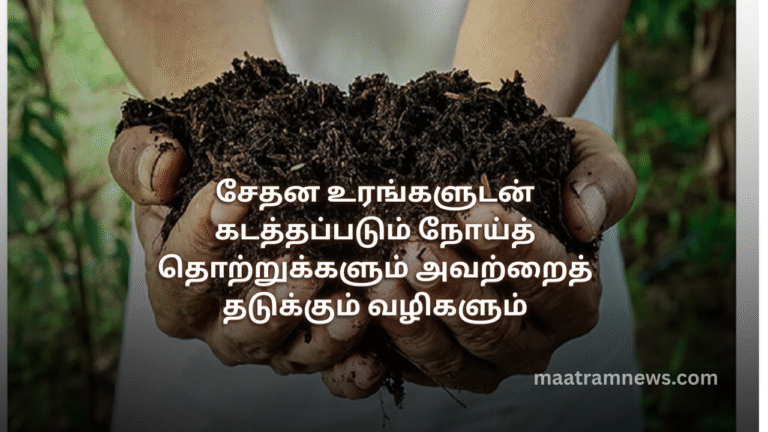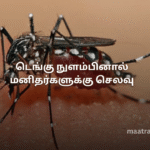சேதன உரங்களுடன் கடத்தப்படும் நோய்த் தொற்றுக்களும் அவற்றைத் தடுக்கும் வழிகளும்
மாட்டெரு, ஆட்டெரு, கோழி எரு, கொம்போஸ் உரம் போன்றவை தாவரங்களுக்கு பேரூட்டச்சத்துக்களை வழங்கும் சிறந்த போசணை மூலங்கள் என்பதில் எவ்வித மாற்றுக்கருத்துகளும் இல்லை.
ஆயினும் முறையாகத் தொற்றுநீக்கிப் பயன்படுத்தாத பட்சத்தில் நம்மை அறியாமலே பல சந்தர்ப்பங்களில் தாவரங்களுக்குத் தீமை செய்யும் சில நுண்ணுயிர்கள் (Pathogens) மற்றும் வேர்ப்புழுக்கள் (Nematodes) போன்றவை இவற்றினூடாக பயிர்களுக்கு கடத்தப்பட்டு நோய் விளைவிக்கும் சந்தர்ப்பங்களும் சில வேளைகளில் ஏற்படுகிறது.
சில வருடங்கள் முன்பு கிழக்கில் வினைத்திறனாக வழிநடத்தப்படும், பெரிய பண்ணையொன்றில், மூன்று நிரைகளில் பயிரிட்ட கறி மிளகாய் கன்றுகளில் ஓரு நிரையில் மட்டும் பக்டீரீய வாடல் அவதானிக்கப்பட்டது. இடுபொருட்கள் பற்றி விசாரித்த போது அந்த நிரைக்கு மட்டும் பண்ணைக் கழிவான கோழி எரு கொடுக்கப்பட்டது எனத் தெரிவிக்கப்பட்டது. இந்த நோய்த்தாக்கம், முறையாக தொற்றுநீக்கம் செய்யப்படாத கோழி எரு மூலம் பரவியிருக்க அதிக வாய்ப்புகள் உள்ளன.
பிரபலமான விவசாய ஏற்றுமதி நிறுவனமொன்றின் வழங்குனரான ஓர் இயற்கை விவசாய அமைப்பின் மத்திய மாகாணத்தில் அமைந்துள்ள ஓர் தோட்டத்திலும் மரக்கறிப் பயிர்களில் முறையாக தொற்றுநீக்கம் செய்யப்படாத சாணம் மூலம் பரவியிருக்கலாம் எனக் கருதப்பட்ட வாடல் நோய், இடுபொருட்கள் மூலம் தொற்றுக்கள் கடத்தப்படும் சந்தர்ப்பங்களுக்கு மற்றுமோர் உதாரணமாகும்.
நாம் அரிதாக கேள்விப்படக்கூடிய வகையில் தென்னிலங்கையில் உள்ள விவசாயி ஒருவரது தோட்டத்தில் முறையாக சுத்திகரிக்கப்படாத கோழி எரு கொடுக்கப்பட்ட சில தென்னங்கன்றுகள் கூட வாடல் நோய்க்கு உள்ளாகிய சம்பவம், சிலவருடங்கள் முன் இடம்பெற்றது.
பங்கஸ், பக்டீரிய வாடல் நோய் மட்டுமல்லாது ‘அண்மைக் காலங்களாக இலங்கை முழுவதும் நெல் வயல்களிலும், தோட்டங்களிலும் பரவலாக அவதானிக்கப்படும் வேர்ப்புழுத்தாக்கம் கூட, கொம்போஸ் தயாரிக்கும் முறையான அறிவின்றி குளக்கரைகளில் அள்ளிவந்து சேர்த்த சேறு, சில வகை நீர்த்தாவரங்கள், தொற்று நீக்கப்படாத எரு, கோழி எச்சம் போன்ற பண்ணைக்கழிவுகள் போன்றவற்றால் முறையான படிநிலைகளுக்கூடாக அல்லாமல் அவசர அவசரமாக தயாரிக்கப்பட்ட சேதன உரங்கள் மூலம் கூட பரவியிருக்கலாம்’ என்பது எமது ஆலோசகர்களான நுண்ணுயிரியல் ஆராய்ச்சியாளர்கள் சிலரின் கருத்தாகும்.
இவைகளுக்கெல்லாம் மூல காரணம் மேற்கூறிய இடுபொருட்கள் வழியே கடத்தப்படும் நோய்த்தொற்றுக்களாகும்.
எரு வகைகளிலே, கோழி எருவே வேர்ப்புழுக்கள் மற்றும் நோய் விளைவிக்கும் பங்கஸ் மற்றும் பக்டீரியாக்கள் பல மடங்கு அதிகமாகப் பெருகக்கூடிய சாதகமான காரணிகளைக்கொண்டுள்ளது.
இப் பாதிப்புக்களை நிவர்த்தி செய்ய,
வணிகரீதியிலோ அல்லது தனிப்பட்டரீதியிலோ சேதன உரம் தயாரிக்கும் போது, சரியான வழிகாட்டல்கள் மற்றும் பரிந்துரைக்கப்பட்ட முறையில், கால அளவுகளின் பிரகாரம் நன்கு உக்க வைக்கப்பட்டுத் தயாரித்தல் வேண்டும்.
கோழி எருவினை பயிர்களுக்கு நேரடியாக இடுவதை தவிர்த்து கொம்போஸ் ஆக மாற்றியபின் பயிருக்கு இடலாம். முடியாவிடின் நன்கு வெய்யிலில் உலர்த்தி இடலாம்.
தயாரிப்பின் முடிவுப்பொருளான கொம்போஸ் 2000 கிலோவிற்கு, பங்கஸ் தொற்று நீக்கியான ட்ரைக்கடெர்மா 1 லீற்றர், பேசிலஸ் சப்டிலிஸ் 1 லீட்டர் மற்றும் வேர்ப்புழு கொல்லியான பேசிலோமைசிஸ் 1 லீற்றர் என்னும் அளவில் சேர்த்து நன்கு கலக்கப்பட்டு பொதியிடப்படலாம். அல்லது மேற்கூறியவற்றை நன்கு கலந்து மூன்று நாட்கள் சேமித்து வைத்தபின் பயன்படுத்தலாம்.
ஆட்டெரு , மாட்டெரு கோழி எரு என்பன நன்கு உலர்ந்திருத்தல் மாத்திரமன்றி, இரண்டு மெட்ரிக் தொன்னிற்கு 1 லீற்றர் எனும் அளவில்
பங்கஸ் தொற்று நீக்கியான ட்ரைக்கடெர்மா , பேசிலஸ் சப்டிலிஸ் மற்றும் வேர்ப்புழு கொல்லியான பேசிலோமைசிஸ் 1 லீற்றர் என்னும் அளவில் தேவையான அளவு சிறிது நீருடன் சேர்த்து விசிறப்பட்டு நன்கு புரட்டிக் கலக்கப்பட்டு 1 – 2 வாரமளவில் நிழலான இடத்தில் வைக்கப்பட்ட பின்னரே பயிர்களுக்கு இடப்படவேண்டும் .
மேற்கூறியவை கிடைக்காத பட்சத்தில் பஞ்சகாவ்யா, ஜீவாமிர்தம் போன்றவற்றைத் தயாரித்து நிலத்துக்கு தொடர்ந்து வார அட்டவணைப்படி கொடுக்கவேண்டும்.
இயற்கை விவசாயத்தில், பயிர்களுக்கு நோய் வருமுன் காப்போம். நேர மற்றும் பண விரயத்தைக் குறைப்போம்.
மேலதிக விபரங்கள்
CSJ Agri
076 225 0017
மேலதிக தகவல்களுக்கு மாற்றம் செய்திகள் இணையத்தளத்தினுள் பிரவேசியுங்கள்.
மேலதிக தகவல்களை உடனுக்குடன் பெற்றுக்கொள்ள மாற்றம் செய்திகள் முகநூல் பக்கத்தை பின்தொடரவும்.
Diseases Carried Through Organic Fertilizers and Their Preventive Measures
🍃🍃🍃🍃🍃🍃🍃
Cow dung, goat dung, poultry manure, and compost are undeniably excellent sources of nutrition for plants.
However, if not properly disinfected and treated, in many instances these fertilizers can unknowingly carry harmful microorganisms (pathogens) and nematodes, which may spread to crops and cause serious diseases.
🍃
A few years ago, in a large farm in the Eastern Province, bacterial wilt was observed only in one row of chili plants, although three rows were cultivated. Upon investigation, it was revealed that only that particular row had been given poultry manure from farm waste. This strongly suggested that the infection may have been carried through improperly disinfected poultry manure.
🍃
In another case, at a vegetable farm belonging to a leading agricultural export company, wilt disease was suspected to have spread through untreated farmyard manure. This again highlights the risk of infections being transmitted through organic inputs.
🍃
Similarly, several years ago in southern Sri Lanka, coconut seedlings in a farmer’s field developed wilt after being treated with untreated poultry manure.
🍃
Not only fungal and bacterial wilt diseases, but in recent years nematode infestations have been increasingly observed in paddy fields and vegetable gardens across Sri Lanka. Experts in microbiology believe that these nematodes may also have spread through hastily prepared organic fertilizers — such as compost made from pond sludge, certain aquatic weeds, untreated manure, and poultry waste — without following proper composting procedures.
🍃
Thus, the root cause of many such problems is the transmission of pathogens through organic fertilizers.
🍃
Among all manures, poultry manure provides the most favorable conditions for the rapid multiplication of nematodes, fungi, and harmful bacteria.
To overcome these issues:
🍃
- Whether for commercial or personal use, organic fertilizer must always be prepared by following proper guidelines and recommended composting procedures, allowing adequate time for decomposition.
🍃
- Poultry manure should never be applied directly to crops. It should first be converted into compost. If composting is not possible, it should at least be dried thoroughly in the sun before application.
🍃
- To 2000 kg of finished compost, mix thoroughly:
- Trichoderma (fungal bio-control agent) – 1 liter
- Bacillus subtilis (bacterial bio-control agent) – 1 liter
- Paecilomyces (nematode killer) – 1 liter
This mixture can be packed immediately or stored for three days before use.
🍃
- Cow dung, goat dung, and poultry manure should not only be properly dried, but also treated by mixing with the same bio-control agents:
- For every 2 metric tons of manure, add 1 liter each of Trichoderma, Bacillus subtilis, and Paecilomyces, dilute in water, spray, and mix well.
- Keep the mixture in a shaded place for 1–2 weeks before applying it to crops.
🍃
- If the above inputs are unavailable, alternatives such as Panchagavya and Jeevamrutha can be prepared and applied to the soil on a weekly schedule.
👉 In natural farming, let’s protect crops before diseases occur.
👉 This will reduce both time and financial losses.
For further information:
CSJ Agri
📞 076 225 0017



